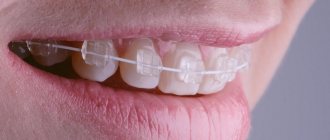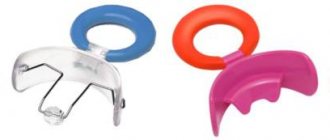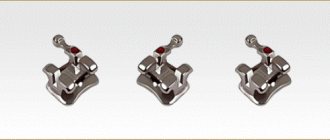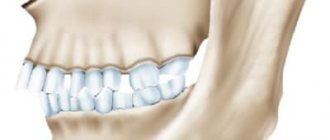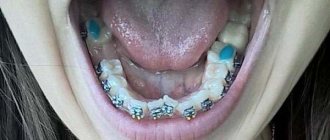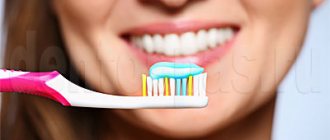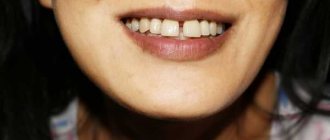It's never too late to take care of a beautiful and healthy smile. Age is not a barrier for orthodontic treatment. Patients with braces after 40 are a fairly common occurrence in modern orthodontics. Nowadays they even install braces after 50 and achieve good results. The braces boom is explained by the natural desires of people to be healthy and beautiful at any age.
A correct, symmetrical bite and straight teeth decorate and transform your appearance in a matter of seconds. External metamorphoses can transform a person’s character. A person with a beautiful smile becomes confident, internally free, and cheerful. He laughs more often, not afraid to show off his perfect teeth.
Do you want to look younger than your real age without plastic surgery? The best way is a healthy smile. It visually rejuvenates a person by 5-10 years.
What type of braces system is better to install after 30 years?
For adults, doctors often recommend choosing classic metal braces because they are the most effective and fastest option. Unfortunately, they are very visually noticeable and can cause damage to the mucosa.
However, aesthetic properties are important for an adult, especially if his work is related to representative activities. Ceramic and sapphire systems are more invisible , which significantly reduce the likelihood of damage to the mucous membrane.
Their prices and treatment times are higher. There are non-ligature or lingual systems that are either not visible on the teeth at all or are barely noticeable.
At your first visit, your doctor will determine what level of correction you will need.
Taken into account:
- individual characteristics of the oral cavity;
- general health;
- your requests for price and quality of material.
Based on these indicators, the doctor recommends the optimal system and offers suitable options.
Optimal age for correction
Age is not a contraindication for teeth straightening , although in adults it has its own characteristics. Treatment will take longer than in adolescents (the average period is 3 years, but can last up to 5 years).
Preparation for installation of the system also takes longer, and some teeth may need to be removed. After removing braces, you will have to wear retainers, in some cases permanently.
Reference ! A retainer is a thin, rigid wire that is placed on the back of your teeth to maintain their new position. You need to wear it at least twice as long as braces.
Adult systems
In orthodontics, braces are installed on the front tooth wall (vestibular) or the inner plane (lingual). Systems differ according to the materials used :
- metal;
- ceramic;
- sapphire.
The most affordable adjustment system: classic vestibular metal braces. They allow treatment to be carried out as quickly as possible, but they are very noticeable and can injure the soft tissues in the mouth. However, the metal system is valued for a number of advantages:
- quick results;
- system strength, resistance to external influences;
- large selection of metal materials;
- Almost all bite pathologies can be treated;
- low cost.
Important ! Metal braces require careful oral hygiene.
More information about metal braces is given in this useful video:
Ceramic
Such systems are almost completely invisible, because you can choose the shade of the material to match the tone of your tooth enamel. But they require much more careful treatment than metal; it will be necessary to change your eating style.
Treatment times are longer than with metal and the price is higher. The undeniable advantages of ceramic braces :
- fewer visits to the doctor;
- stable results, reliability of the entire structure;
- less chance of mucosal damage;
- short period of adaptation.
Ceramic braces can be installed for simple defects, incorrect closure of the jaw arches, or crooked position of one or a small number of teeth. The system is not suitable for treating severe curvatures.
Important ! The results of changes in the bite can be seen within two months after the installation of braces.
You will learn about the advantages of ceramic braces and the stages of installing the system in this video:
Sapphire
The material from which this system is made is artificial sapphire. It is completely transparent, so the braces are almost invisible on the teeth. The downside is the long correction period in complex cases.
The cost of such models is significantly higher than others. But there are also advantages:
- invisible on the teeth;
- no trauma to the mucous membrane;
- strength is higher than that of ceramic models;
- sapphire does not become cloudy over time or upon contact with food coloring;
- easy to install, quick to get used to;
- the correction is effective.
Important ! Sapphire braces are transparent, so the natural yellowish tint of the teeth will be noticeable, and their aesthetic component will decrease.
The sapphire system is installed for a longer period than models made from other materials. The simplest defect will take at least a year to correct . If improperly maintained and used, there is a risk of breakage; the strength of the system is still less than that of metal, although greater than that of ceramics.
You can learn about the features of sapphire braces from this video:
Unligated
The most modern correction method. This model is called self-regulating, because it lacks the element connecting the power arc with the locks.
The arc is secured with special locks or clips and is not rigidly fixed in the grooves of the plates.
Advantages of the non-ligation system:
- fewer visits to the doctor;
- teeth move gently and physiologically, which reduces the likelihood of complications;
- improves oral hygiene;
- the comfort of treatment is increased due to the small size of the braces;
- the mucous membrane is not injured;
- the period of adaptation is quite short, there is no pain or discomfort;
- aesthetic appearance.
The disadvantages include the high cost of such a system, which is associated with the specifics of the mechanism. Installation is not carried out in all clinics; working with such braces requires certain qualifications of a doctor.
Any materials are used in the system:
- metal;
- ceramics;
- composite;
- sapphire.
Treatment with non-ligature braces is described in this video:
Lingual
The location of these braces is moved to the inner surface of the teeth, which completely hides them from others. In addition to the obvious aesthetic component, there are other advantages of the system :
- complete invisibility to others;
- 3D modeling technology allows you to predict the result before installation;
- adjustments can be made at any time during treatment;
- the period of adaptation is very short;
- Even complex cases are successfully treated.
Lingual braces take a long time to install, which is not very comfortable for the patient. Taking care of your mouth becomes more difficult, and as you get used to it, speech defects or difficulty eating may appear.
You will need to visit the doctor more often, which increases the cost of general treatment. The price of the entire system is higher than other models.
Contraindications for installing linval braces are problems with the mandibular joint, severe torsion and low crowns. The wearing time of the system increases by approximately 30% compared to other options.
Basic information about lingual braces is given in this video:
Contraindications
With age, the list of contraindications for wearing braces increases .
The adaptation mechanisms of the body as a whole decrease, the mobility of the maxillofacial system decreases, and there may be serious dental problems (for example, the absence of a significant number of teeth). In addition, there is a list of diseases for which correction with braces is prohibited:
- malignant tumors;
- mental disorders;
- diseases of the blood and immune system;
- HIV infections;
- diabetes;
- periodontitis or periodontal disease;
- osteoporosis or osteomalacia;
- complex heart pathologies;
- tuberculosis.
If any of these diseases are detected after the installation of braces, the system is immediately removed and remission is expected.
Some patient conditions allow the installation of braces, but require additional and more careful monitoring by a doctor. These include:
- bronchial asthma;
- hormonal disorders;
- rheumatoid atritis affecting the mandibular temporal joint;
- endocarditis;
- poor oral hygiene;
- the presence of implants or prostheses.
Important ! Installation of a brace system is carried out only after a comprehensive examination of each patient for the presence of contraindications.
Alternative methods
Aligners are a mouth guard made of silicone or polymer , which is made from an impression of the patient’s teeth.
It puts constant moderate pressure on the teeth and requires regular replacement when the dentition shifts. The use of aligners will be effective only in the simplest cases of correction, and their cost is quite high. The advantages of such a system:
- comfort and aesthetics of use;
- Remove aligners only for brushing teeth or eating;
- the result is easy to predict;
- Dental problems can be treated at the same time;
- oral hygiene is not complicated;
- mucous tissues are not injured;
- The adaptation period is short, using the mouth guard is very simple.
Important !
It is forbidden to install aligners in the presence of severe somatic diseases, anomalies in the development of the jaw arches, dental plaque and periodontal pathologies.
New technologies
The latest technologies have appeared in correcting bites, which have made a real revolution in orthodontics. The new method involves making a patient a set of 15 to 36 clear trays that fit tightly to the teeth so that they are virtually invisible. They follow the shape of the teeth as accurately as possible, with the exception of those places where there are curvatures. Each tray has a specific shape and corresponds to a specific stage of treatment. They need to be changed every two weeks in a strict manner prescribed by the doctor. In addition, the patient receives a spare set of mouthguards in case of damage. You must wear the mouth guards all the time; you can only remove them when eating and brushing your teeth. For greater effectiveness, the orthodontist prescribes special gymnastics to the patient, which is performed using special dental simulators. You need to do these exercises every day for 20–30 minutes.
Unfortunately, it is possible to correct the bite of an adult using this “braces-free” method only when it comes to minor problems. In addition, such complex high-tech treatment cannot be cheap and its price is not affordable for everyone.
Braces at 30 – 40 years old
Those who believe that it is too late to get braces at 30 are deeply mistaken. Modern orthodontic systems make it possible to straighten teeth and correct bites up to 45 years of age. Treatment in adulthood has its own characteristics, but in the end it is as effective as in youth.
Is it worth getting braces after 30 years?
Many are sure that after 30 years it is no longer useful to get braces, as well as to arrange your personal life. These are outdated stereotypes that are no longer relevant today for the following reasons.
- Dentistry has made great strides forward and has high-tech and more effective orthodontic treatment methods.
- The age of marriage is increasing, many people start families at 30–35 years old and later, when they have already made a career. Naturally, a young woman getting married will want to get her teeth in order, something she never had the opportunity to do before. After all, a smile is an important attribute of attractiveness that men pay attention to.
- After 30 years, physiological displacement of the lower row of teeth begins, crunching, clicking may appear, and facial aesthetics may deteriorate.
- A previously uncorrected bite is one of the main reasons for the development of cervical osteochondrosis and headaches in young people.
On a note!
According to doctors who are specialists in the field of orthodontics, the effectiveness of treatment with braces after 30 years is quite high if it is carried out in a qualified manner.
Which braces are better to choose?
In adulthood, you have more chances to choose braces; you can also afford those made from expensive materials - ceramic, sapphire, gold plated, it is a matter of taste and possibilities. But regarding the type of fixation of the system, the final word remains with the specialist.
Correction of teeth and bite after 30 years is more problematic, so preference is given to external or vestibular braces, they can be:
- metal;
- plastic;
- ceramic;
- transparent sapphire.
How long should you wear braces?
The period of wearing braces is individual for each patient, determined by the nature and severity of the deformation. But it will be longer on average by 6 to 12 months than with correction in adolescence, when bone tissue is more pliable.
Important!
In total, treatment may take 1–3 years; in the future, you will still have to wear retainers or mouth guards to consolidate the result.
Photos before and after treatment are presented below.
Advantages and disadvantages of installing the system on teeth after 30
The decision to get a beautiful smile for those over 30 has a strong motivation. Straightening teeth and bite using a braces system expands a person’s capabilities and provides a number of advantages:
- eliminates complexes, improves social adaptation in the team and society;
- expands opportunities for professional growth and career;
- helps improve personal life, especially for women;
- eliminates crunching and pain in the mandibular joint;
- reduces the likelihood of developing osteochondrosis, reduces headaches.
Only under such conditions can the desired result be obtained. Therefore, it is necessary to weigh the pros and cons in advance, taking into account your capabilities.
Alternative ways to straighten teeth
Other orthodontic devices are also used to correct and improve the appearance of teeth: aligners, trainers, veneers, luminars.
Aligners (aligners)
These retainers are used in mild cases of tooth deformation by placing corrective caps on them. They are made individually using virtual 3D modeling based on casts of the jaws and a photograph of the face. The aligners are removable, but only for a short time for cleaning your teeth. Wearing period is 1 year.
Trainers
They are silicone plates, they are used in addition to braces or on their own, worn only at night to correct small curvatures of the front teeth.
Veneers and luminars
Removable dental onlays, made from impressions, have a purely aesthetic purpose. They do not correct, but only mask defects:
- spots;
- chips;
- uneven height of teeth, gaps between them.
Luminaries are analogues of veneers, but thinner, masking only small defects. The question of choice: veneers or braces should be decided with a specialist.
Reviews
At the age of 31, I decided to correct my crooked front teeth and bite. I got ceramic braces and wore them for 4 years without any problems. Then I wore mouth guards for a little over a year. The teeth before and after are like heaven and earth, they haven’t come apart and are still fine.
Anna
It wasn’t until I was 32 that I took care of my crooked teeth. First I had to undergo treatment and fill all the holes. I wore braces for 2.5 years, then retainers for the same amount of time. I'm happy with the result. Don't be afraid, look for a good specialist and install it.
Irina
Bottom line
And at 30-40 years old you can get braces and get good results. This is confirmed by numerous reviews from patients who have found a beautiful smile and improved their quality of life.
You're welcome
You can change your bite at any age - as long as a person still has his own teeth. Of course, the younger the person, the faster and easier it is to correct the bite. Up to 12–14 years of age, that is, until the complete change of teeth, you can do without braces, doing this with the help of plates alone. After the age of 14, when a teenager has all his permanent teeth, braces can no longer be avoided. After 28 years, the process is complicated by the fact that the bone tissue is fully formed, so changes will occur more slowly, and it will also take more time to consolidate the effect. All this, of course, represents some difficulty, but is by no means an obstacle. Thanks to improvements in braces and other advances in modern dentistry, the procedure for correcting a bite has become much less painful and more comfortable than before. It just requires more patience from an adult.
Article on the topic
It is better to correct the bite in childhood. Which braces are right for your child?
Braces at 30 - does it make sense to get them - Ochkov.net encyclopedia
Orthodontic treatment gives the best results in childhood. It is easier to correct malocclusion in children, since their jaw and teeth are just developing. However, this does not mean that braces are contraindicated for adults. They can be installed even after 30 years, but the treatment process will be longer. Let's consider its features.
The formation of the dental system ends around 17-18 years, but a child’s permanent bite is formed by 12-13 years. It is best, according to dentists, to install braces at the age of 10-12, when the last molars grow.
However, it all depends on individual characteristics. Sometimes doctors suggest waiting a bit for the jaw to form without braces. And in some cases, on the contrary, their immediate installation is required. The need for such treatment is determined primarily by medical indications, and only then by the patient’s wishes.
Should I get braces after 30?
Many people believe that installing braces after 30 years is pointless, dangerous or painful, so they refuse orthodontic treatment. However, it is worth understanding that malocclusion, which can develop in various forms, can cause many complications. Among them:
- Caries, gingivitis and other oral diseases that occur due to poor hygiene and uneven distribution of chewing load.
- Pain in the jaw, which can radiate to the temples and eyebrows, which is a consequence of compression of the nerves and joints.
- Rapid wear of some teeth, abrasion of enamel, loss of teeth.
- Diseases of the gastrointestinal tract due to poor chewing of food.
- Psychological problems associated with self-esteem and complexes that an ugly smile gives rise to.
Why is this necessary?
There may be medical indications for correcting the bite - for example, when the incorrect position of the teeth causes discomfort, injures the gums or interferes with chewing food normally. But most often we are talking about one or another aesthetic defect that one wants to correct. If a person has “suffered” his bite until he is quite old and does not need dental prosthetics, then most likely it is the second case.
By the way, there are cases when the procedure to correct a person’s bite is contraindicated. So, it is not done for osteoporosis, severe diseases of the cardiovascular system, infectious and oncological diseases.
Contraindications
Correcting the bite and straightening teeth with braces is possible for patients over 30 years old, provided they have no contraindications to this method of treatment.
Absolute (complete) restrictions are the following states:
- malignant oncology;
- neuropsychiatric disorders;
- periodontal disease;
- diabetes;
- HIV infection;
- diseases of the blood and immune system;
- pathologies of the skeletal system: osteoporosis, osteomalacia;
- absence of a large number of teeth;
- complex heart pathologies;
- tuberculosis.
In addition to absolute restrictions, there are also relative ones, in which installation and wearing of systems is possible only under the constant supervision of a doctor.
This group of contraindications includes:
- poor blood clotting;
- bronchial asthma;
- rheumatoid arthritis with damage to the mandibular temporal joint;
- endocarditis;
- insufficient oral hygiene;
- hormonal disorders;
- the presence of implants and dentures in the oral cavity.
Important: before starting treatment, each patient undergoes a complete examination of the body and oral cavity to determine the indications/limitations for orthodontic treatment.
Price issue
The financial side of the course of treatment is directly related to the type of braces chosen. The total cost consists of such components as the material used to make the structure, the place and method of fastening, and the actions of the doctor.
In the proposed table, you can study the approximate price of each previously discussed system and find out the total cost of treatment, taking into account all preparatory procedures and control visits.
| Type of correction device | Cost, thousand rubles. | Total cost of treatment, thousand rubles. |
| Non-ligature braces | from 20 | up to 70 |
| Lingual system | from 45 | up to 110 |
| Ceramic braces | from 30 | up to 160 |
| Sapphire design | from 45 | up to 200 |
| Aligners (set of 10 pcs.) | from 25 | up to 150 |
All indicated figures may change upward or downward, based on the pricing policy of the clinic, its location and status, the qualifications of the doctor, etc.
In the video, a current dentist will complement the information presented above.
Where to go for quality dental treatment?
Patients from young to old seek help. Some care about prevention, others come for urgent treatment, and others come for a beautiful smile and lasting results. They all choose “Art Smile” because:
- this is high-quality care in the most difficult cases, which doctors at other clinics refuse;
- first-class specialists who undergo training abroad and constantly improve their skills;
- guarantee for services, the corresponding clause is stated in the contract with the client;
- comfortable, painless treatment using modern equipment;
- maximum attention and care to each patient.
SPECIALIST CONSULTATION IS REQUIRED. THERE ARE CONTRAINDICATIONS.
Author: Advertising INFPOL.RU
Optimal age for correction
There is no age limit in the list of contraindications related to the installation of braces. This means that a person can straighten teeth and correct improper jaw closure, regardless of how old he is.
However, correction of dental anomalies in adult patients has a number of fundamental differences from the treatment of children or adolescents.
So:
- Longer preparation will be required with the possibility of some teeth being removed.
- The main correction period lasts much longer (up to 3-3.5 years).
- The movement of dental units follows the dentoalveolar type.
- Additional orthodontic devices may be used simultaneously with braces for certain indications.
- The retention period also increases, and for some patients wearing retainers will be recommended on a permanent basis.
According to experts, the most “valuable” period for orthodontic intervention is considered to be the age of 12-20 years , when the best results can be achieved even with complex maxillofacial anomalies.
This age criterion is associated with the period of active formation of the dentition and the peak of skeletal growth. The effect on the musculoskeletal structure has a maximum effect, and solving problems with occlusion is easier, faster and of better quality. The tendency for re-curvature is minimal.
In a person whose age is approaching his fourth decade, the growth processes in the body stop, and the condition of not only the gum tissue and teeth themselves, but also the body deteriorates.
All this negatively affects the quality, volume and very possibility of treatment. But it is impossible to refuse orthodontic correction in case of pronounced disorders.
Orthodontists insist on its mandatory implementation, regardless of age, since dental anomalies lead to the following consequences:
- early tooth loss;
- exposure of the dental neck;
- premature wear of enamel;
- rapid wear of the mandibular temporal joint;
- periodontitis;
- multiple caries;
- dysfunction of the facial muscles;
- cracking and chipping of the enamel coating;
- the occurrence of pain in the head, back, neck;
- damage to bone and soft tissues in the oral cavity;
- difficulties in restoration and prosthetics of teeth;
- breathing problems;
- changes in diction;
- disruption of the digestive system;
- distortion of facial aesthetics.
Also, refusal of correction may subsequently result in the need to replace your own teeth with prosthetic structures, implants, or long-term expensive treatment. In some cases, neglect of treatment results in complex surgery.
Important! The question of the advisability of orthodontic intervention in older age should be resolved only positively, in the absence of absolute medical contraindications.
Evaluate the results of teeth straightening with braces using photos before and after treatment.
Come here if you are interested in how long you need to wear braces.
At this address https://orto-info.ru/sistemyi-vyiravnivaniya-zubov/breketyi/kak-chistit-osnovnyie-pravila.html we will tell you how to brush your teeth with braces.
Alternative methods
Aligners are an alternative to braces for correcting dental anomalies. They represent a transparent orthodontic mouthguard, made only to order from hypoallergenic material (silicone, polymer) according to an impression of the oral cavity of a particular patient.
The principle of their influence is based on a small but constant pressure on the dentition. After a slight displacement of the problematic elements, one product is replaced by another.
Due to the moderate pressure force, the use of aligners is indicated only for the correction of simple dental anomalies:
- mild crowding of teeth;
- gaps between the teeth in the frontal zone;
- minor malocclusions;
- rotation of dental elements;
- discrepancy between the parameters of the jaw arches and the norm;
- abnormally long coronal parts of individual units.
Wearing this type of mouth guard is prohibited in case of severe somatic diseases, skeletal anomalies in the development of the jaw arches, hard dental plaque, and periodontal pathologies.
The main advantage of this correction is the patient’s comfort and emotional stability. Other advantages of using the structures in question are:
- high aesthetics;
- predicted result;
- no allergy to the material;
- do not injure the mucous membranes and tissues of the mouth;
- it is allowed to combine bite correction with the treatment of certain dental diseases;
- do not complicate oral hygiene;
- easy to use;
- do not require special care;
- short adaptation period;
- There is no dietary restriction.
The disadvantages include:
- long production;
- inability to correct complex malocclusion pathologies;
- high cost of the correction course.
The technique is effective only for permanent dental units. They are made as a set, i.e. During the entire course, the patient must periodically (approximately every 1-2 months) replace one product with another . Based on the specifics of the clinical case, from 8 to 40 pieces may be required for the entire treatment period.
You can get the desired result in about 10-12 months. constant wearing. The structure can only be removed while brushing your teeth and eating.
Let's figure out together whether it hurts to put braces on your teeth.
In this publication, we will find out what factors make up the cost of braces systems.
Here https://orto-info.ru/sistemyi-vyiravnivaniya-zubov/breketyi/u-zvezd.html read which celebrities wore braces.
